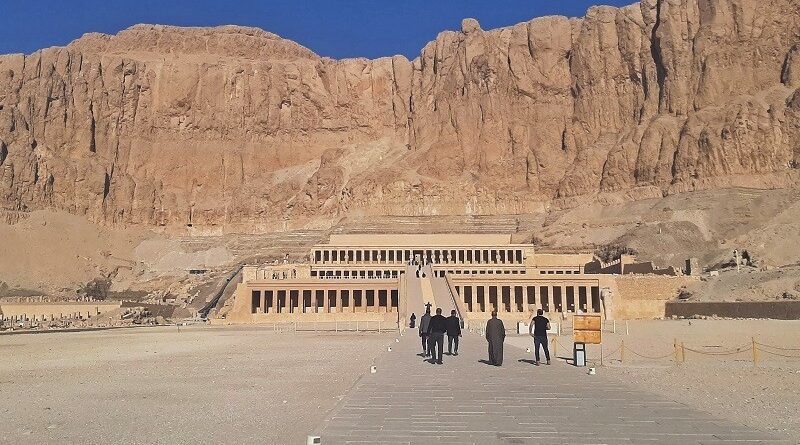The Temple of Hatshepsut: A Visit to a Unique Mortuary Temple
This destination guide covers a visit to the Mortuary Temple of Hatshepsut near Luxor, Egypt.
A visit to the Temple of Hatshepsut
The last part of my Nile cruise itinerary was a visit to the Mortuary Temple of Hatshepsut, located just outside the city of Luxor.
The imposing Cliffs of Deir el-Bahari separate the Valley of the Kings from the Temple of Hatshepsut.
After our visit to the Valley of the Kings earlier in the morning, we thus had to drive for about 10 minutes around these mountains to reach the Hatshepsut’s mortuary temple.
Having parked our car at the lot, my guide Mohammed and I passed through the entrance building.
Right before us, we could already see the majestic temple built against the steep cliffs.

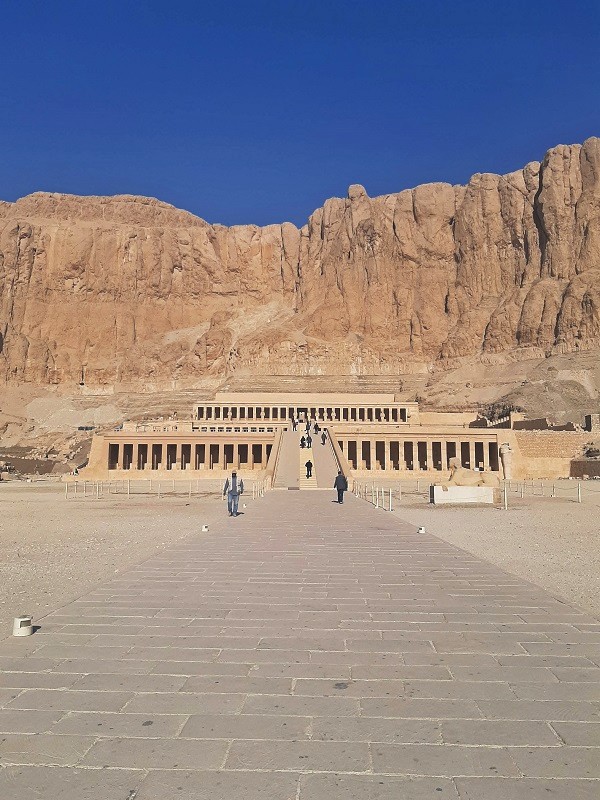
About the Temple of Hatshepsut
The Temple of Hatshepsut takes its name from the female Pharaoh Hatshepsut, who ruled over Egypt from around 1479 BC until her death in 1458 BC.
Hatshepsut was the primary wife of Pharaoh Thutmosis II and upon his death, she assumed control over Egypt as a regent given that her stepson, Thutmosis III, was just two years old at the time.
Even after Thutmosis III came of age, Hatshepsut continued to be a co-ruler of Egypt.
Hatshepsut commissioned the construction of her own mortuary temple in Deir el-Bahari to celebrate her accomplishments and to honour the gods Hathor, Amun and Anubis.
The temple was never intended as a mausoleum, as Hatshepsut was laid to rest in a tomb located in the Valley of the Kings (archaeological site KV20) at the other side of the steep cliffs of Deir el-Bahari.
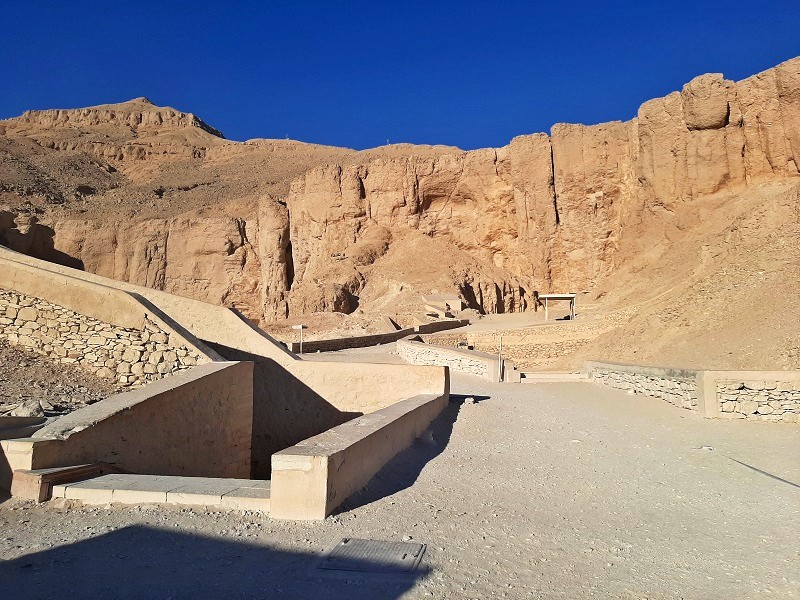
Walking towards the temple
As you walk towards the temple you can see a large statue of a Sphinx.
The pathway leading to the temple was once adorned with dozens more Sphinx statues, much like the Avenue of the Sphinxes in Karnak.
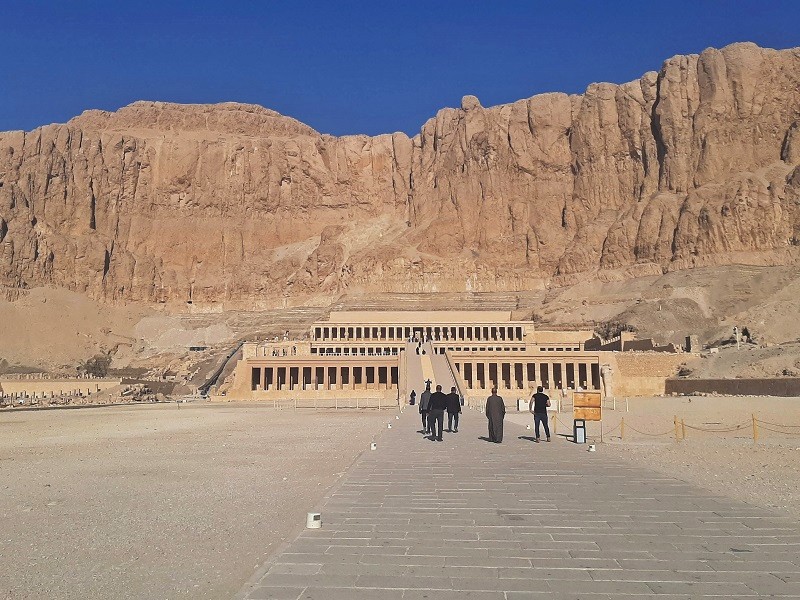
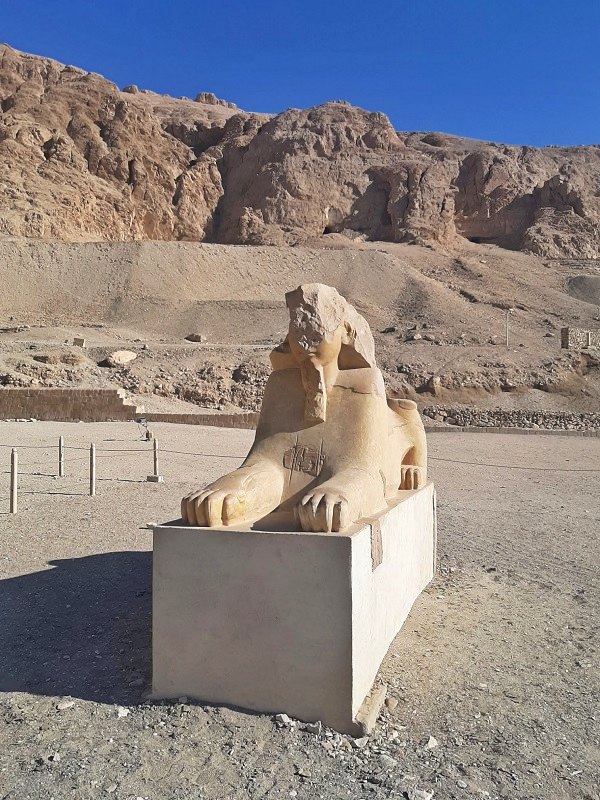
Temple architecture
The Temple of Hatshepsut has a relatively simple yet elegant design which blends in perfectly with the natural surroundings of the bleak cliffs of the Deir el-Bahari.
However, its structure with three levels of colonnaded terraces and a broad staircase is simply imposing and the temple is rightly considered as an architectural masterpiece.
As is customary in Egyptian temple design, every element holds symbolism or serves a specific purpose.
The road from the banks of the River Nile towards the Temple of Hatshepsut used to be the way over which the barque of Amun-Re was carried during the Beautiful Festival of the Valley, which was held annually in Thebes (the ancient name of what is now the city of Luxor).
The barque, a sort of ceremonial boat on which statues of gods were placed during processions, was then placed in the shrine of Amun-Re inside the temple for offerings and rituals, before it was taken back to Karnak.
While the entrance road was constructed along an east-west axis, the Temple of Hatshepsut is aligned directly against it on a south-north axis.
Inside the temple along the length of this axis, were various halls and shrines adorned with images that depicted the life cycle of Pharaoh Hatshepsut, spanning from her coronation to her journey into the afterlife.
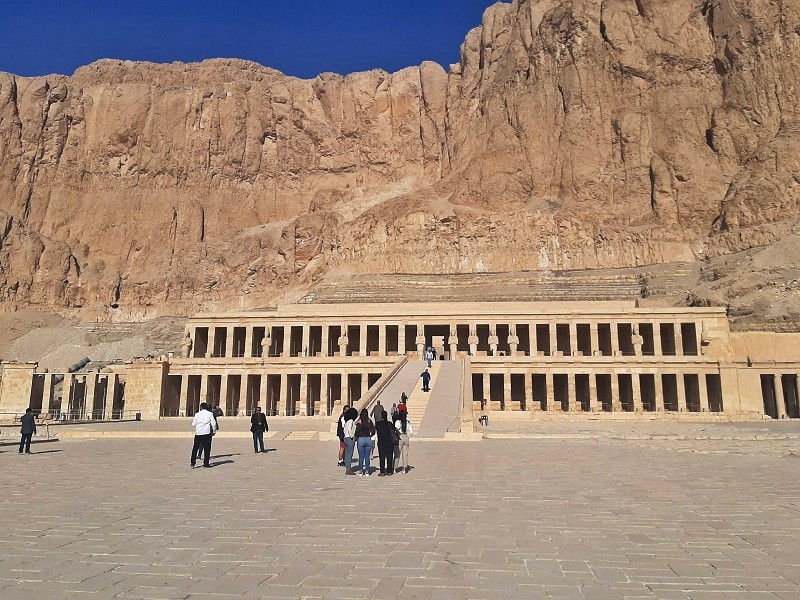

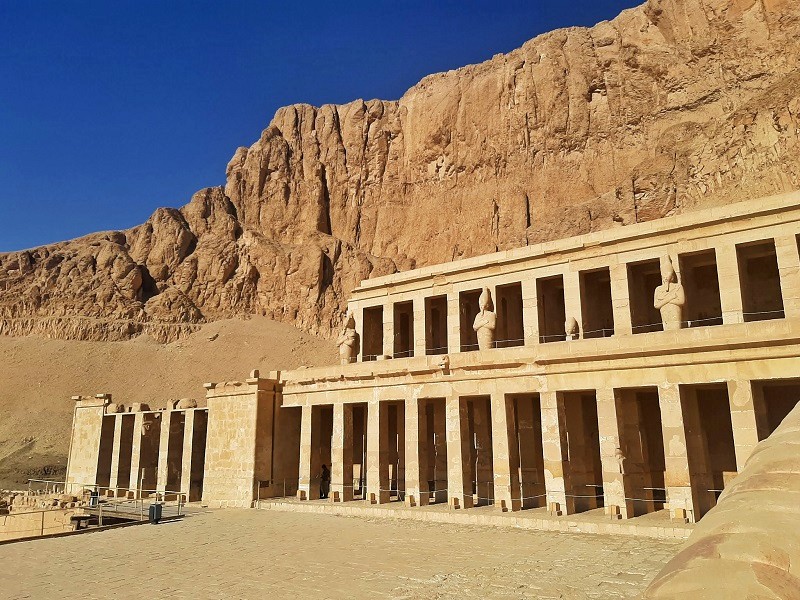
Shrine of Anubis
The first part of the Temple of Hatshepsut which my guide Mohammed and me entered was the shrine dedicated to Anubis.
This part of the temple has some of the best preserved reliefs and paintings.
Make sure to look upwards as well, as the ceiling shows a beautiful pattern of white stars against a blue backdrop symbolising the sky.
Above an alcove, you can observe a splendid painted relief featuring Pharaoh Thutmose III presenting offerings to the falcon god Horus.
Within the recess, you can observe a depiction of the god Anubis with his jackal-head, although the figure opposite him has been erased.
Pharaoh Hatshepsut was originally depicted here, but all images of her within her own mortuary temple have been erased, vandalised, or destroyed.


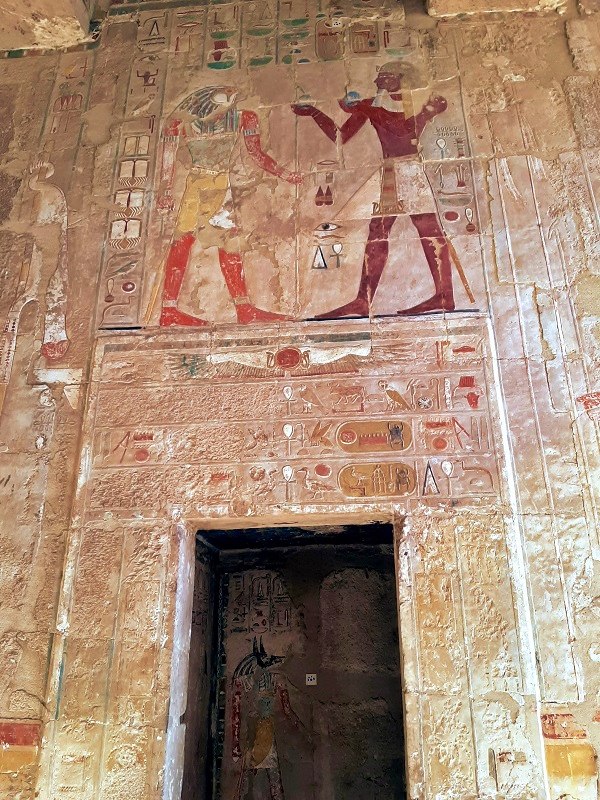
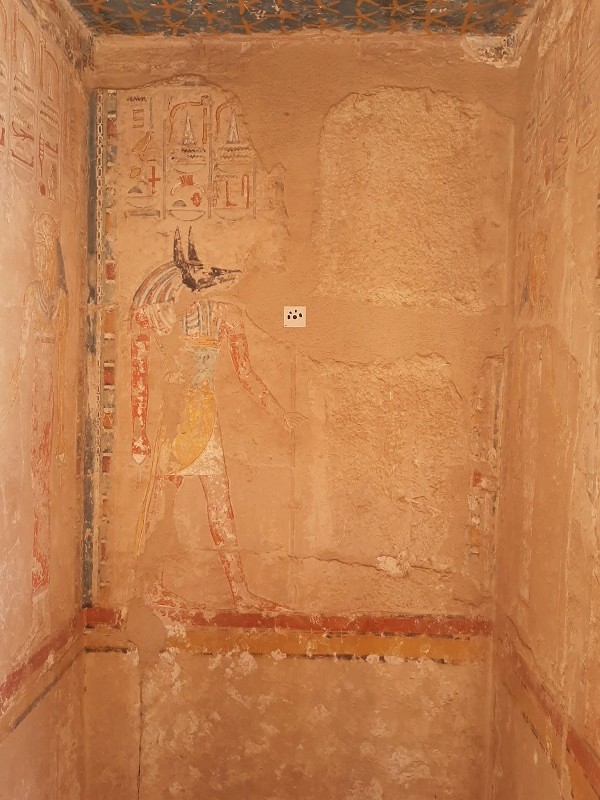
Destruction and erasure
About two decades after Hatshepsut’s death, a deliberate effort was made to erase her reign from memory, attribute her accomplishments to others, and remove her from the annals of history.
Throughout Egypt, her images were erased and statues smashed to pieces.
This included Hatshepsut’s own funerary temple, as you can’t find any depiction of her anymore.
Archaeologists and historians aren’t entirely certain about the reasons behind the erasure of Hatshepsut’s legacy, which started during the end of the reign of her stepson Thutmosis III but which was halted soon after his successor Amenhotep II took power.
Some suggest that the campaign to erase Hatshepsut was initiated by her stepson out of jealousy or due to lingering resentment, as he was overshadowed by her during the initial period of their co-regency.
Although Thutmosis III may have wanted to downplay her achievements in order to legitimise some accomplishments as his own, there wasn’t however any animosity between the two.
Indeed, only Hatshepsut’s role as Pharaoh has been erased, while records of her as the royal wife of Thutmose II, for example, were left intact.
It thus appears more probable that the motive behind the erasure of Hatshepsut’s legacy is related to cultural or religious factors, given that her reign was somewhat of an anomaly in the male-dominated society of Ancient Egypt.
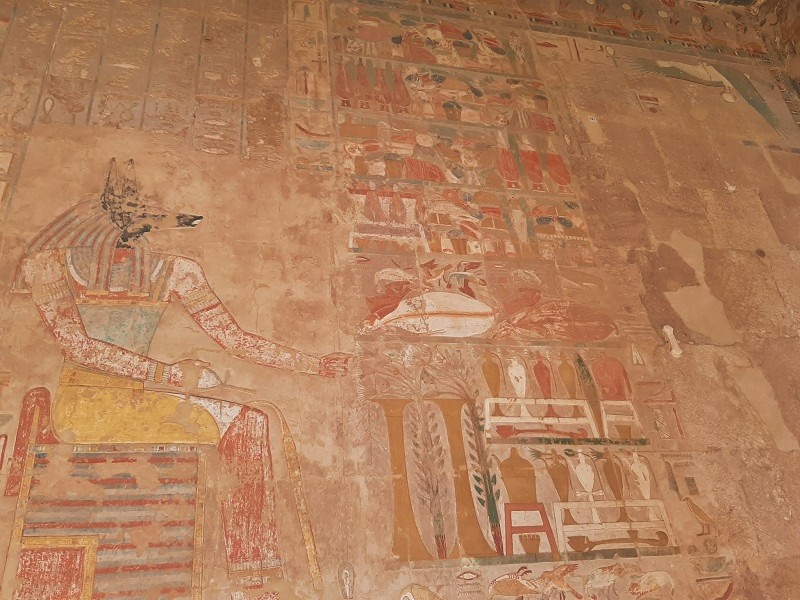
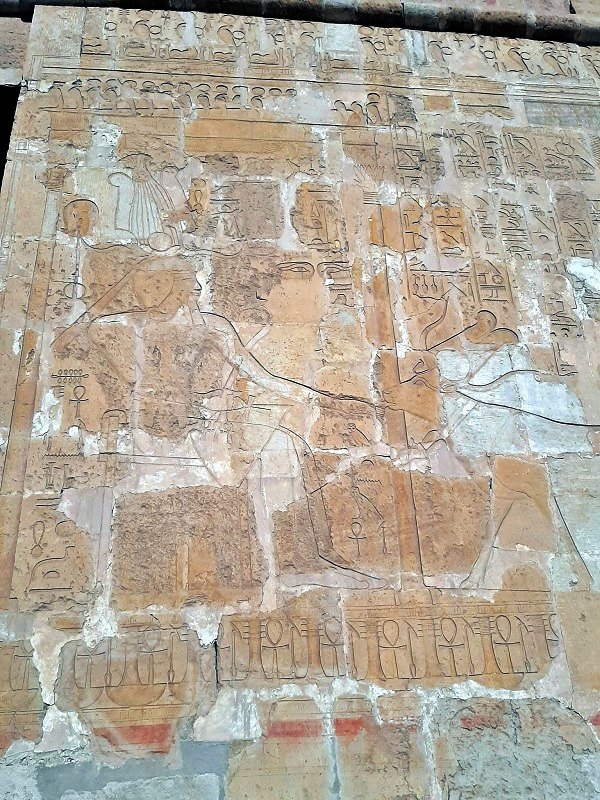
Exploring the rest of the temple
Due to the destruction of numerous painted reliefs and statues, along with the passage of centuries causing many others to deteriorate, the Temple of Hatshepsut isn’t the most interesting of Ancient Egyptian temples to explore.
The fact that this ancient temple was used as a monastery by Coptic Christians from the 6th to the 8th century AD, and that numerous original reliefs were painted over with images of Christ, further impacted the preservation of its original historic character.
Having already visited so many fabulous temples and tombs during my journey across Egypt, the Temple of Hatshepsut therefore felt like somewhat of an anti-climax.
There are however still a few beautiful frescoes and reliefs left to admire, and you can’t help but be impressed by the grand scale of the Temple of Hatshepsut itself.
Ensure that you walk up to the upper terrace, where a collection of Osiris statues is positioned along the columns – some of them still in pristine condition, while others are destroyed or decayed.




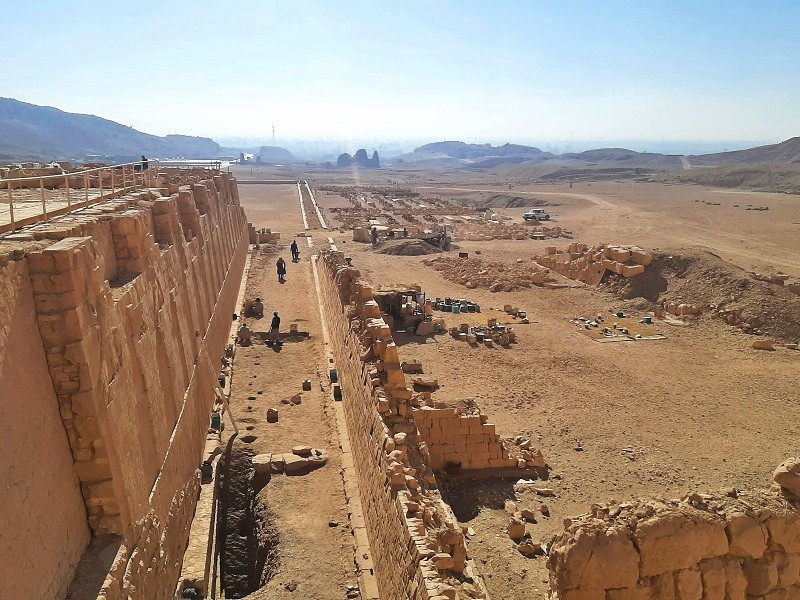
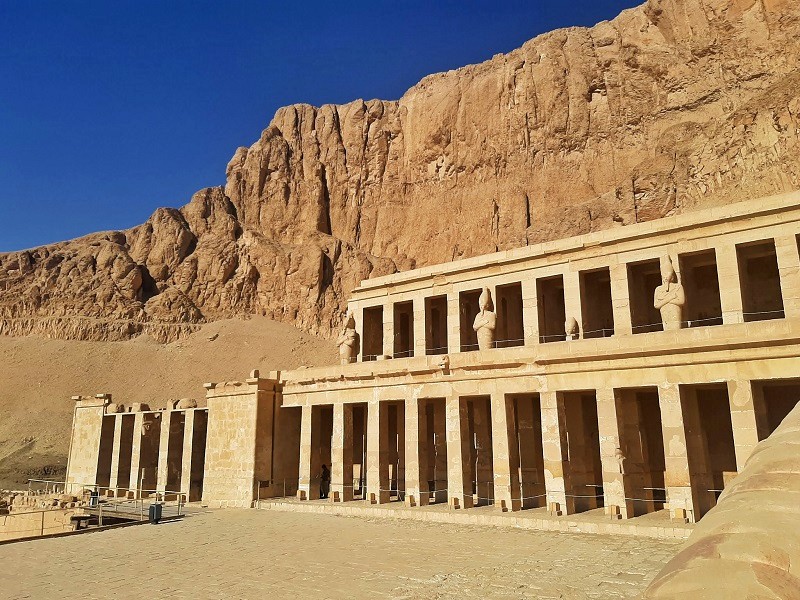


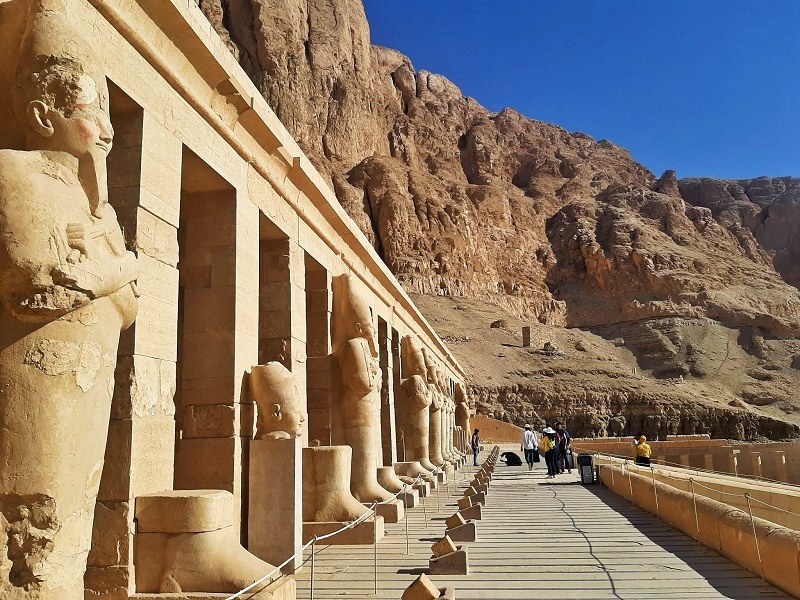

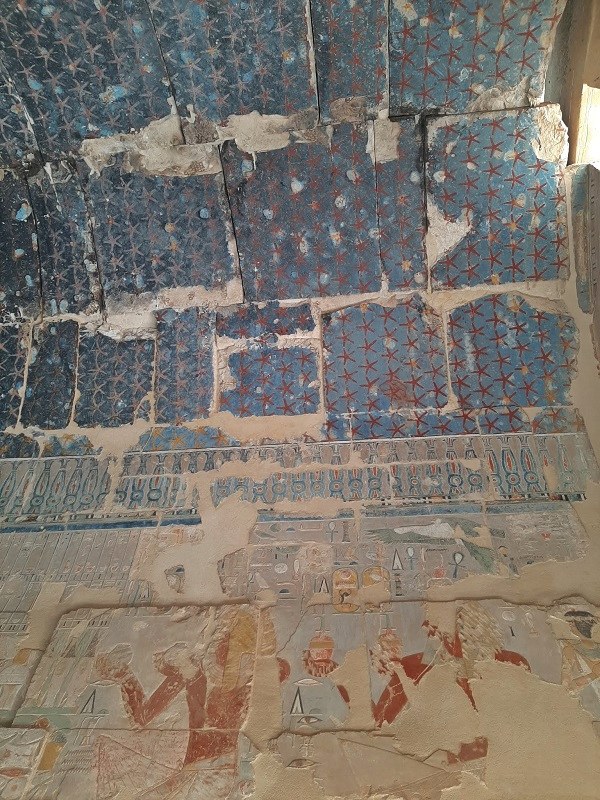

Leaving the temple
After the guided tour of the temple and some free time to walk around the complex on my own and snap some more pictures, Mohammed and I walked back to the parking lot.
Since the Temple of Hatshepsut marked the final destination on my Nile cruise itinerary with my guide Mohammed, we concluded our visit with a selfie together as a memory of the incredibly fascinating journey.

Colossi of Memnon
On our way back from the Temple of Hatshepsut to the city of Luxor, we made another stop at the Colossi of Memnon, as this site happened to be located right along the way.
These statues portray Pharaoh Amenhotep III and were originally positioned in front of his mortuary temple, which unfortunately was damaged over time due to floods and an earthquake.
They derive their name from the Greek word Memnonium, which was used to refer to the entire necropolis of Ancient Thebes.
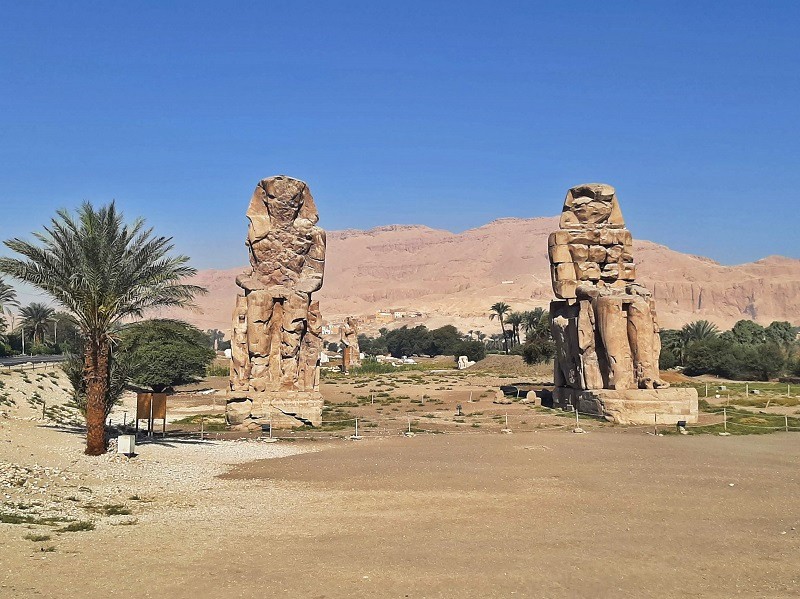
To the Winter Palace
After the brief stop at the Colossi of Memnon, we continued our drive back to Luxor.
Mohammed and our private driver left me in front of the Winter Palace, the hotel where I would spend my final night in Luxor before heading back to Cairo.
After expressing my gratitude to Mohammed for his excellent guidance throughout the entire Nile cruise, I entered this famous historic hotel.
It would later prove to be an exceptionally good choice for my last night in Luxor, but that’s a topic for the next chapter of this trip report.

Conclusion
The Temple of Hatshepsut just outside Luxor showcases one of the most impressive architectural designs among all archaeological sites in ancient Egypt.
This terraced temple with three different levels beautifully blends in with the surrounding cliffs.
The story behind the temple and how all depictions of the female Pharaoh Hatshepsut were erased after her reign is intriguing.
However, this also means that there aren’t a whole lot of intact reliefs, frescoes and statues inside the temple.
As imposing as it appears from the outside, in comparison to other temples and tombs I visited during my journey across Egypt, there isn’t that much to see and to explore within the confines of the Temple of Hatshepsut.
Trip report index
This article is part of the ‘Walk Like an Egyptian: A Grand Tour of Egypt‘ trip report, which consists of the following chapters:
1. Red-Eye Ramblings of a Late Night Flight to Cairo
2. A Visit to the Pyramids of Giza by Camel
3. Review: Sofitel Nile El Gezirah, Zamalek, Cairo
4. Exploring the Medieval Old Town and Islamic History of Cairo
5. Visiting the Museum of Egyptian Antiquities in Cairo
6. Mar Girgis: The Churches of Christian Old Cairo
7. Review: Ernst Watania Sleeping Train Cairo to Aswan
8. The Ancient Quarry of Aswan and the Unfinished Obelisk
9. A Boat Ride From Aswan to the Temple of Isis at Philae
10. A Visit to the Aswan High Dam and Lake Nasser
11. A Visit to the Nubian Village on Aswan’s Elephantine Island
12. Aswan Guide: A Visit to Egypt’s Most Stunningly Located City
13. A Half Day Trip From Aswan to Amazing Abu Simbel
14. Nile River Cruise Guide: All Info for Your Egypt Boat Trip
15. Review: M/S Princess Sarah Nile River Cruise Ship
16. Nile Cruise: Sailing From Aswan to Kom Ombo
17. A Visit to the Ancient Crocodile Temple of Kom Ombo
18. A Visit to the Temple of Horus at Edfu
19. Nile Cruise: Sailing From Edfu to Luxor
20. Luxor, Egypt: Visiting the Sights of Ancient Thebes
21. A Visit to Luxor’s Giant Temple Complex of Karnak
22. Visitor Guide to Wonderful Luxor Temple
23. Valley of the Kings: A Visit to Luxor’s Ancient Necropolis
24. The Temple of Hatshepsut: A Visit to a Unique Mortuary Temple (current chapter)
25. Review: Sofitel Winter Palace Hotel, Luxor, Egypt
26. Review: Daytime Train Luxor to Cairo, Egypt
27. Review: Steigenberger Hotel El Tahrir, Cairo
28. A Visit to the Pyramid of Djoser and the Saqqara Necropolis
29. A Visit to the Dahshur Pyramid Complex
30. Memphis: Exploring the Old Capital of Ancient Egypt
31. From Cairo to Alexandria by Train: My Travel Experience
32. Review: Paradise Inn Le Metropole Hotel, Alexandria, Egypt
33. Alexandria: A Visit to Egypt’s Historic Mediterranean Port City
34. Egypt: Impressions and Reflections After My Two Week Trip
35. Epilogue: Safety and How to Deal With Street Hassle in Egypt

